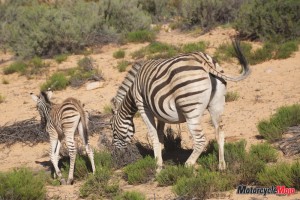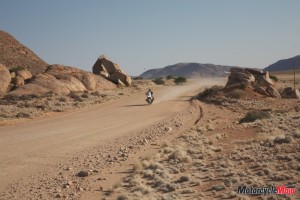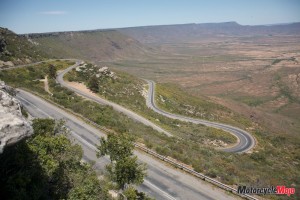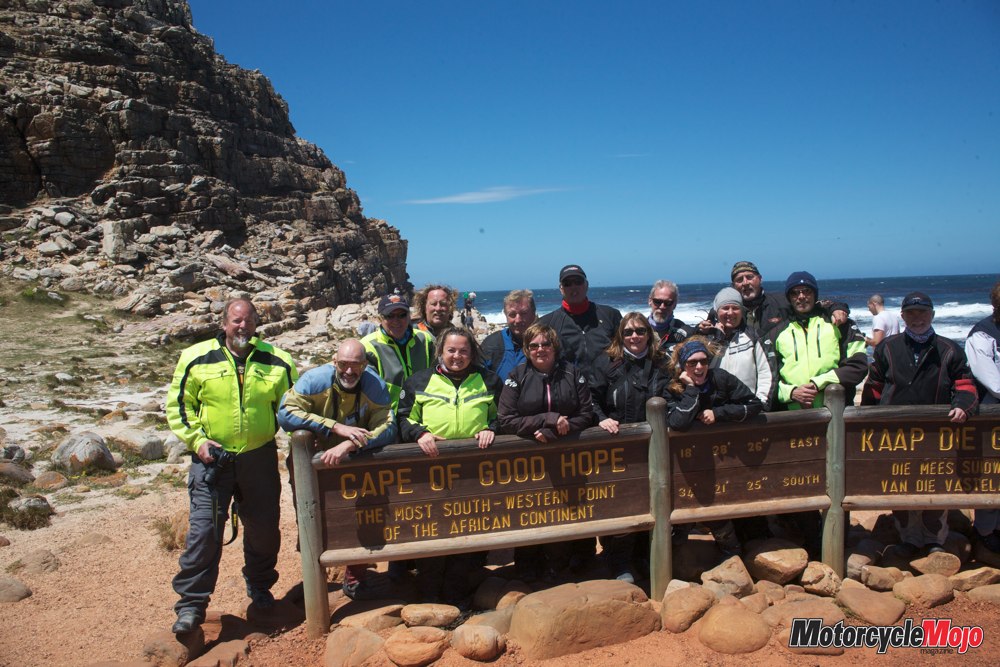From dust to diamonds, cobras to kudu, Namibian desert to high mountain passes, the last half of the tour offers a varied landscape, spectacular riding and a wide cross-section of African culture
Part One, in the March 2014 issue, described our visit to Etosha National Park and our first few days of riding in Namibia on the Spectacular South West Africa tour.
Day V – Helmeringhausen to Lüderitz
Namibia is beautiful but desolate. With a total population of only 2.1 million people, the road system is sparse; in some cases, it might be 100 km or more between crossroads, making it impossible to get lost. It’s because of these stretches that we were able to depart Helmeringhausen in the morning at our leisure and meet the rest of the group at the next intersection.
The gravel road was in immaculate condition – hard packed and about four car-widths wide – allowing for some spirited riding. Then, without warning, the soft sand and deep gravel reared its ugly head again for about 10 kilometres. The words of those who are smarter than me entered my mind: “Never let your guard down and always expect the unexpected.” A mantra every motorcyclist should heed.
There were a few bikes already stopped when Gwen and I pulled up to the end of the road. I spotted Debra on her hands and knees. Not knowing what had happened, I jumped off my bike quickly, only to realize she was kissing the pavement and thanking her lucky stars that she and Jim made it to the end of this particularly treacherous stretch of soft gravel in one piece.
After regrouping and regaining our composure, we continued our travels on a 120 km/h paved highway through flat desert that changed to endless dunes as we approached Kolmanskop. The land on both sides of the public highway is owned by a diamond mine company, and markers about three metres from the highway’s edge let visitors know that it is illegal to venture off the highway.
The diamond field around Kolmanskop was exhausted by the 1950s, and the Namib Desert is reclaiming the diamond-mining ghost town as abandoned houses are gradually filling up with sand. Once home to the southern hemisphere’s first X-ray station and Africa’s first tram, it was an interesting way to spend a couple of hours exploring the once-opulent buildings.
As we arrived in Lüderitz, we found the town had been without power for two days prior to our arrival, but it was restored shortly after we checked in. Built on black lava rock, Lüderitz was once a predominant shipping port on what is known as Africa’s inhospitable Skeleton Coast. The Nest Hotel is located right on the rocky coastline, and looking out our windows was reminiscent of being on a cruise ship with the vast 180-degree view of water and rock.
Day VI – Lüderitz to Cañon Lodge
 Leaving Lüderitz, it was 15 C, the coolest temperatures we had experienced yet, but it quickly rose to 33 once we were amongst the dunes, and by the time we arrived at the Cañon Lodge, it was a dry desert heat of 37.
Leaving Lüderitz, it was 15 C, the coolest temperatures we had experienced yet, but it quickly rose to 33 once we were amongst the dunes, and by the time we arrived at the Cañon Lodge, it was a dry desert heat of 37.
The day’s lunch stop was at the Seeheim Hotel. Seeheim was once a bustling town, but it was short lived – abandoned in the seventies. A long, steep gravel road led us to the hotel, which had recently been restored to its former glory.
Entrepreneurs have realized the need for accommodation in rural Namibia. As with the restoration of the Seeheim Hotel, Helmeringhausen and the creation of the Agama Resort, our next night at the Cañon Lodge proved this. We were constantly in awe of these amazing resorts that just seemed to appear in the middle of nowhere, like a mirage. This is a massive benefit of being on an organized tour – all of the food, fuel and accommodation research is done, so you can simply show up with gear, ready to ride.
The grounds of the Cañon Lodge were littered with strategically placed derelict vehicles inside and out, some with large quiver trees growing out of them. It was all very unique, and as with most places we visited, it was hard to put your camera down.
Next to the Grand Canyon, Fish River Canyon is the second-largest canyon in the world at 160 km long, up to 27 km wide and, in places, 550 metres deep. After our luggage was in our rooms and the trailer unhooked from the van, we drove to the canyon to explore and watch the sunset.
Day VII – Cañon Lodge to Springbok, South Africa
 The days just seemed to keep getting better, and it’s hard to believe, but this would be our most scenic day yet. The day began with scenery that I would imagine the moon or Mars to possess. We rode through massive fields of round stones the size of coconuts that progressed into huge piles of house-sized, round boulders – the piles of which might be 100 metres high and continue for many kilometres.
The days just seemed to keep getting better, and it’s hard to believe, but this would be our most scenic day yet. The day began with scenery that I would imagine the moon or Mars to possess. We rode through massive fields of round stones the size of coconuts that progressed into huge piles of house-sized, round boulders – the piles of which might be 100 metres high and continue for many kilometres.
Ai-Ais hot springs, which means “burning water” in the local Nama language, is located between two sheer rock faces, and the gravel road going into the canyon with its twists and elevation changes was the most entertaining road we had ridden on to date. The water from the natural hot spring is diverted to a swimming pool, but you can feel the heat from it on your face as it exits the earth at 65°C.
Leaving Ai-Ais, we rode beside a galloping herd of about 30 oryx that eventually crossed the road in front of us. The terrain was becoming less desert-like and more mountainous, and the foliage seemed to be getting greener as we headed south to the Orange River, the natural border between Namibia and South Africa.
The border crossing consisted of five checkpoints, and it took about 30 minutes to get under way again. I noticed a difference between South Africa and Namibia shortly after crossing the border. Of course, the terrain was the same on both sides of the river, but South Africa seemed more advanced; the road construction was plentiful and there were many more paved roads.
A large braai (barbecue) with far too much food at the Okiep Hotel in Springbok, South Africa, finished the day.
Day VIII – Springbok to Stonehenge

This would be the longest riding day of the tour at approximately 485 km with a mix of gravel and pavement – many of the days were around 300 to 350 km, with our shortest riding day pegged at close to 175 km.
Lunch was at the summit of a huge tabletop mountain, but more importantly for Emily, John and me, it was a chance to enjoy the twisty ride down and back up the mountain on immaculate pavement.
Today we would be on the longest gravel road between two towns in South Africa, and with no risk of getting lost, we were able to go at our own pace and stop when we liked. Gwen and I were riding alone when we passed a large, copper-coloured snake on the road. By the time I turned around for a better look, Bob had already stopped and was taking video of it. I slowed down beside it and it reared up, proving with its large, flat head that it was a cobra. By the time Chuckie (one of our guides) arrived in the chase van, it had slithered off into the brush.
Chuckie loves snakes and will drive for hours to rescue one from someone’s house. He has been bitten many times, spent weeks in hospitals and has almost died, but he continues to rescue them. When he saw Bob’s video he knew it was a Cape Cobra, the second deadliest snake in southern Africa. He noticed in the video that it appeared to have been injured, and this caused concern for Chuckie. Fearless, he walked into the brush wearing just shoes and shorts and started to pull back the bushes looking for it; his hope was to capture it and nurse it back to health. He didn’t find it, but told us that death comes about two hours after you are bitten by one of these snakes, if help is not sought immediately. He then informed us that we were much more than two hours away from anywhere We later found out that Cathy, one of our group, had run over it.
Of all the places we stayed on this trip, Stonehenge was by far the most unique, albeit a little rough around the edges in comparison to the other beautiful and luxurious resorts. Riding on a very rough road across three farms, and past the edge of a small cemetery with rock piles signifying the graves, we came to the edge of more than 8000 acres that house the Tankwa Tented Camp – aka Stonehenge, and the home of AfrikaBurn (similar to Nevada’s Burning Man festival). Bordering the Tankwa Karoo National Park, the tented camp, partly owned by Henk, our tail gunner, contains permanent safari tents with comfortable memory-foam beds, shower and washroom facilities, bar area, restaurant, fire pits and fire-heated hot tub. Interestingly, the vehicle seats surrounding one of the fire pits were taken from the actual vehicles used in Fury Road, a new Mad Max movie, which was partly filmed in Namibia.
Sunsets are a big deal during Renedian Adventures tours, and we ventured off many times to view them. Part of the grandeur of the Stonehenge sunset was the speech that Henk gave just before the sun went down, making it the most moving sunset that I, or any of the other guests, had ever experienced.
Of all the places we had stayed up to that point, the tented camp was the most memorable, partly because it was a late departure the next morning, so we could stay up a bit later in the distinctive bar area, but mostly because of the camaraderie that the evening offered.
Day IX – Stonehenge to Aquila
After stopping for coffee at Tankwa Padstal, a small coffee shop in the middle of nowhere that sold everything from pregnancy tests to horseshoes, we proceeded over the Katbakkies Pass on the gravel and paved – but rough – road. The top of the pass offered views of the massive valley far below and the next set of mountains beyond that.
Henk and Chuckie prepared the day’s safari-style lunch at a scenic look-off on top of Gydo Pass, high above the town of Ceres. Henk told us of the importance to the world’s fruit and juice supply of the valley far below, an area called Africa’s fruit basket.
Our stop for the night was at Aquila Private Game Reserve. This game reserve was the only place in our travels where we saw Africa’s “big five.” This doesn’t refer to actual size, but rather, it reflects how difficult and dangerous the lion, leopard, elephant, Cape buffalo and black rhino are to hunt on foot. Being on foot in a place like this is extremely dangerous, so getting out of the safari vehicle is not permitted. That doesn’t mean you don’t get close to the action; at times, we were only three metres away from hippos, rhinos, lions and elephants. It was here where two elephants forced us to reverse down the road as they walked toward us and showed no signs of backing down.
Aquila is one of the more extravagant places we stayed at during the tour. The patio of our stone cabin looked into the fenced game reserve, and just five metres away were Cape buffalo grazing at the river’s edge.
This was the last day with any gravel, and it was discussed at dinner how everyone would miss the excitement that gravel offered; even those who came on the trip with no previous gravel experience. I should also note that no one went down, even in the most harrowing road conditions. I have to say, congratulations to all of the riders on the tour.
Day X – Aquila to Arniston
It wasn’t surprising that our weather was perfect in a region of Africa that enjoys 300 days of sunshine annually, but it was our turn to hit one of the other 65 days. This was the only day we had rain on the whole trip, but it only lasted for about two hours.
We wound our way down to Cape Agulhas, the southernmost point on the African continent and the official dividing line that separates the Atlantic Ocean from the Indian Ocean. It wasn’t particularly windy as we stood on the rugged coastline, but the waters were extremely turbulent as the currents of the two oceans clashed.
Half an hour away was Arniston, which is half traditional fishing village and half seasonal holiday resort. There is no wharf in town, as the seas are too rough; instead, all of the small fishing boats are brought up on shore after each day’s outing. The original fishing village is a clutter of small, whitewashed houses with thatched roofs, the style of which seems to be unique to the immediate area. Our evening meal was in a small house-turned-restaurant that served traditional dishes, including the catch of the day. The jumbled network of streets didn’t follow any rhyme or reason, but instead, just wound in and out between houses. A few of us got very misplaced in the dark on the way back to our hotel, trudging through backyards and getting turned around many times.
Day XI – Arniston to Stellenbosch
The southern regions boast a healthy economy, as evidenced by the hustle and bustle of the towns. This is largely from the tourist trade, but the farms with cash crops and livestock are far more plentiful, and the foliage is green and vibrant. With first-world culture comes a difference in food as well. What was game in Namibia and northern South Africa gradually vanished from menus, and beef and chicken became the norm as we travelled farther south.
Our first stop of the day was lunch in the town of Hermanus, a pretty town and a tourist hot spot, full of cafés and upscale shops. The centre of town is perched high atop cliffs that look out onto the South Atlantic, and it’s one of the best places in the world to watch southern right whales as they frolic just off shore. In addition to whale watching, the area is rife with beaches up and down the shoreline.
We hugged the coast after Hermanus, cliffs on one side of the road and the most amazing blue ocean on the other, eventually arriving at Monkey Town, a private primate sanctuary where Rene’s wife, Colette, grew up.
As detailed in his book, The University of Gravel Roads, Rene spent four years travelling around the world on his BMW 650 Dakar and fell in love with southern Africa, and with Colette. They kept in touch while he continued his world excursion, and the rest, as they say, is history.
Colette’s mother started Monkey Town as a primate rescue about 20 years ago, and over the years, it has developed according to a concept where the people are enclosed in fenced walkways and the monkeys can freely roam the property’s forested area. Monkey Town features about 300 types of monkeys, baboons and apes, including three chimpanzees.
We finished our day’s ride in downtown Stellenbosch, a region that produces 17 percent of South Africa’s wine. Our accommodation was the Stellenbosch Hotel; whitewashed with black trim, it was built in 1876 and has been declared a national monument.
Day XII – Stellenbosch
This was our second-last day of the trip, and a non-riding day. Stellenbosch is South Africa’s second-oldest town, and the hotel is located in an old, but diverse neighbourhood; there are lots of unique shops, pubs and restaurants for those wishing to just hang around. Gwen tagged along on a wine-tasting tour, while others went on a spirited ride around the local mountain passes with Henk as their guide. Bob, Ian, Paul, Emily and I chose to go cage-diving with great white sharks at Gansbaai, the great white shark capital of the world. It was an exhilarating but menacing feeling, having 4.5-metre meat-eating predators with open mouths – displaying razor-sharp teeth – swimming within arm’s length of the cage.
Day XIII – Stellenbosch to Cape Town
Our last day on the tour was bittersweet, but the day also held some of the most amazing riding. Although it is only 50 km to Cape Town by main roads, we made it a day of riding by way of the Cape of Good Hope and Chapman’s Peak Drive. The day also took a little longer, as Cathy, Jeni and Gwen and I got misplaced in traffic and roundabouts leaving Stellenbosch. One of Rene’s rules at our initial rider’s meeting was that if anyone loses the group, they should go back to the last place the group was together. And the rule works. The four of us went back to the Stellenbosch Hotel and waited for Henk to arrive to lead us to the rest of the group.
We stopped briefly at Boulder Beach to witness endangered African penguins in one of their natural habitats, amongst the long grasses beside the boardwalk and sunning themselves on the beach.
Our trip was nearing an end, and one of our last roads to ride was magnificent. Chapman’s Peak Drive, built between 1915 and 1922, was once regarded as a major feat of engineering, as its 114 curves over nine km were carved out of the mountainside, and it features a sheer cliff face on one side and very long drop to the water on the other side. Before arriving at the tollbooth at the end of the road, many of us turned around for another trip up and down the coast to repeat the thrill of this spectacular ribbon of tarmac.
As we pulled into our final destination, the Protea Hotel on Cape Town’s waterfront, we were all a little melancholy, knowing that when we dismounted our bikes, it would mark the end of 13 days of the most amazing roads and scenery we could ever have imagined.
Bob had it right when he said, “This trip has been like the Cabot Trail, Rocky Mountains and Niagara on the Lake all rolled into one.” Although he did fail to mention the amazing Namib Desert that we experienced.
Ending the Trip of a Lifetime
Somewhere along the trip, Henk said, “This isn’t a culinary tour, nor is it a photography tour, it’s a motorcycle tour.” He could have added that it isn’t a resort tour. I agree to disagree. While it is first and foremost a motorcycle tour, it could easily pass as any of the others. The food was as outstanding as the accommodation and the photo opportunities.
None of us went on this trip with any defined expectations other than to ride motorcycles in a foreign land and to have fun doing it. Every day seemed to exceed the previous day in sights and experiences and the excitement of the road. By the time we reached each day’s destination, we were completely satisfied with the day’s events and the experiences we were fortunate enough to have witnessed.
Jeff mentioned, “The places we stayed and ate at were uniformly great, very often with a unique aspect in the setting, or local experience. The highlights though, were the biking itself and the great places we got to see – there is a huge diversity in a relatively short travel distance in this part of the world, and the combination of all this made for a trip of a lifetime for me.”
There are always water- and food-quality concerns when travelling. While you must get appropriate shots regardless of where you travel, not one of our group had problems. In fact, Paul said, “The food was great and there were no issues with water; despite all the horror stories I heard before I left, none of that was true.”
There is something about Africa that gets into your blood and it just doesn’t let go, drawing you back. After 20 days, we didn’t want to leave. Rene, Henk and Chuckie were perfect hosts – very professional and accommodating – and since this trip was so successful, we will be returning. Motorcycle Mojo will host another Renedian Adventure, the Waterfalls and Wildlife tour, in August 2014. This tour is 99% pavement, takes in six game safaris and includes an overnight stay at Victoria Falls, Zimbabwe. For more information, visit motorcyclemojo.com or renedian.com.

















































